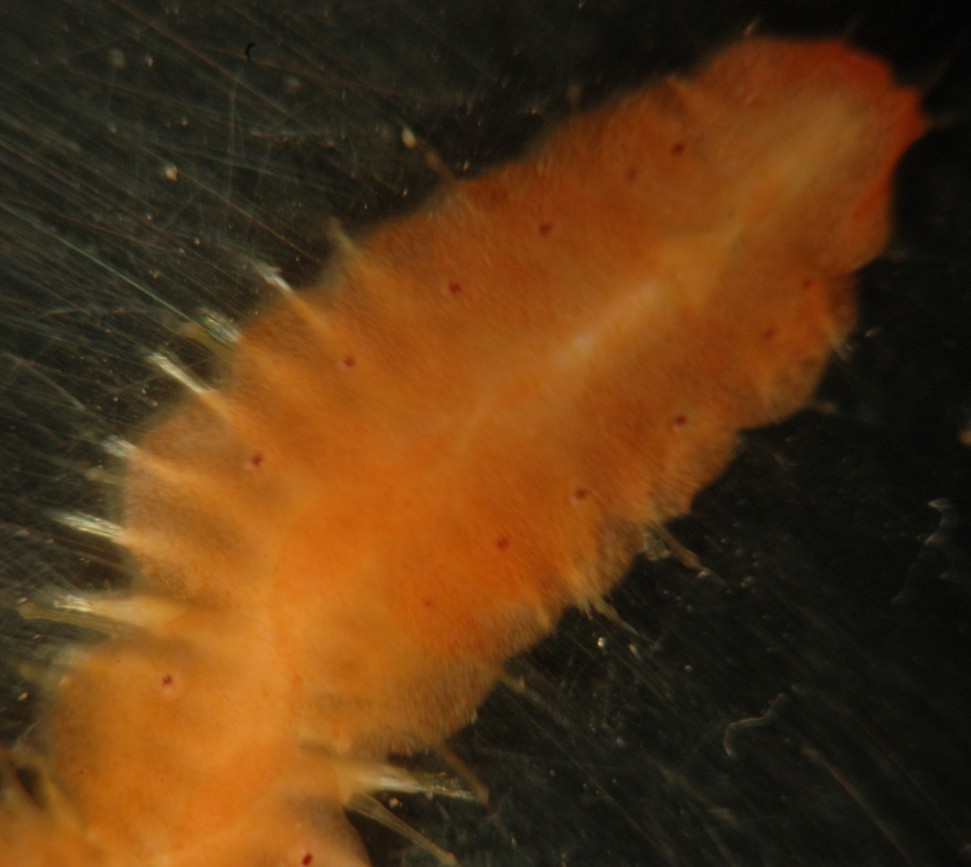Arctonoe pulchra (Johnson, 1897)Common name(s): Red commensal scaleworm |
|
| Synonyms: Polynoe pulchra, Acholoe sp., Halosydna sp. |  |
| Phylum Annelida
Class Polychaeta Order Phyllodocida Superfamily Aphroditidae Family Polynoidae |
|
| Arctonoe pulchra, about 2 cm long. Was living on the sea cucumber Parastichopus californicus caught near Rosario. | |
| (Photo by: Dave Cowles, July 2006) | |
How to Distinguish from Similar Species:Arctonoe vittata has a band of dark pigment extending across segments 7 and 8. Arctonoe fragilis has ruffled or folded margins on the elytra.
Geographical Range: Gulf of Alaska to Baja California, Mexico; uncommon in California
Depth Range: Lower intertidal to 275 m
Habitat: Symbiotic with several invertebrates including sea stars such as Solaster stimpsoni, Pteraster tesselatus, Luidia foliata, and Dermasterias imbricata, sea cucumbers such as Parastichopus californicus and P. parvimensis, and other animals such as Cryptochiton stelleri, Diodora aspera, Megathura crenulata and terebellid polychaetes such as Loimia montagui.
Biology/Natural History: This species is attracted by the smell of its host (if the host is uninjured), but can learn to live with a new species. Its body color is usually close to that of its host. It eats detritus. Adults are territorial and will try to drive other individuals off their host. They may injure or kill one another in fights over a host.
Members of Family Polynoidae, unlike most other errant polychaetes, have parapodia specialized for walking rather than as paddles. Their longitudinal muscles, which caused lateral undulations in other polychaetes, are poorly developed and they don't undulate much. As a result, although they can walk efficiently they are poor swimmers.
| Return to: | |||
| Main Page | Alphabetic Index | Systematic Index | Glossary |
References:
Dichotomous Keys:Kozloff 1987, 1996
Smith and Carlton, 1975
General References:
O'Clair
and O'Clair, 1998
Ricketts
et al., 1985
Sept,
1999
Scientific Articles:
Web sites:
General Notes and Observations: Locations, abundances, unusual behaviors:

The edges of the elytra on this species are smooth, as seen in this
closeup photo. This individual also has a red spot on each elytrum.
Ricketts
et al. says all members of the species have this spot (but that A.
vittata do not), while O'Clair
and O'Clair say that some individuals may not have the spot.
Authors and Editors of Page:
Dave Cowles (2006): Created original page